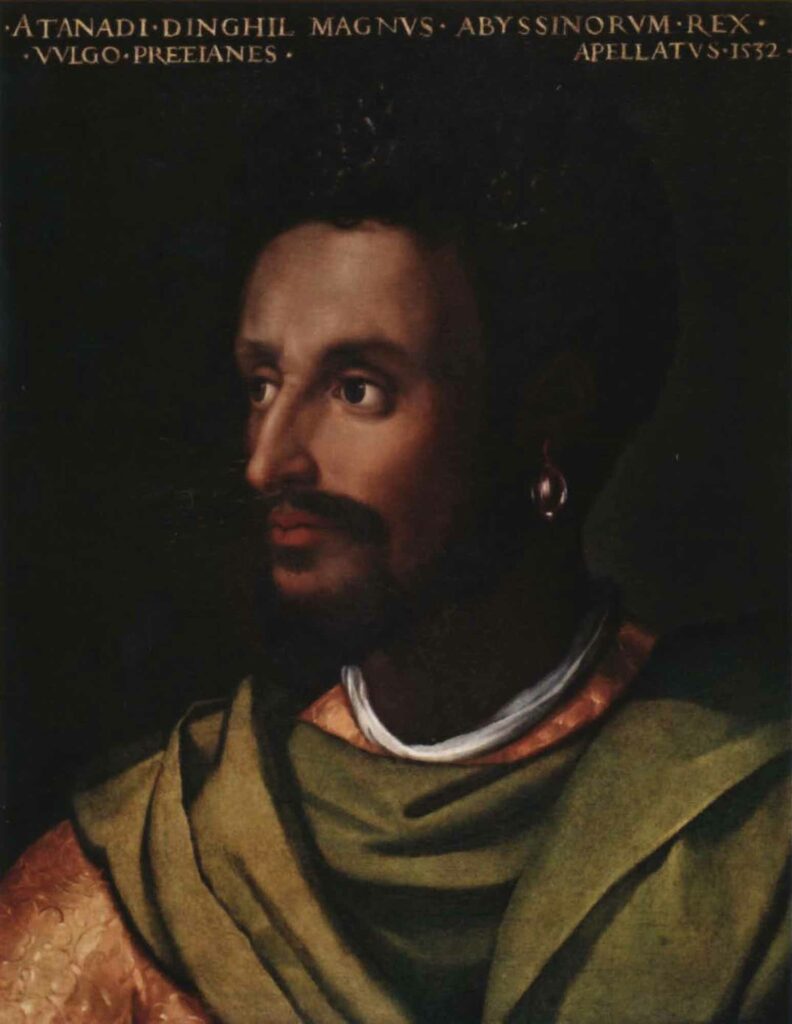Visitors wandering through the Uffizi galleries today pass through the three corridors that line the cortile, the inner narrow courtyard opening to the Arno river on one end and the Piazza della Signoria on the other. Antique sculpture and larger paintings run the length of the halls, as does a series of portraits installed along the top of the walls, directly below the ceilings. Many of these paintings date to between 1552 and 1589, copied by the artist Cristoforo dell’Altissimo as part of a large-scale commission by Cosimo I de’ Medici, from the scholar and historian Paolo Giovio’s vast portrait gallery. Amongst these are two images of black African rulers.
Like many of the other portraits that line the corridor, these are bust-length depictions, painted in oil on wooden panels, roughly 23 inches in height by 17 inches wide, framed in carved walnut. The painting identifying its subject as “Atanadi Dinghil, great king of the Abyssinians, commonly called Prester John,” shows the subject in three-quarters view, all’antica, his head turned to the right. He is a young black man, and he wears a plain, solid green cloth about his shoulders, but the gold of his elegant pendant earring and in the woven pattern of his shirt glitter against the black background, lending a certain air of richness to his person. The inscription on the other portrait reads “Alchitrof Aethiopiae Rex”, “Alchitrof, King of Ethiopia.” Alchitrof holds a mirror, and turns his gaze toward the viewer. The large feather headdress conceals his hair, but his curled beard and mustache and prominent eyebrows are visible. Pieces of white coral decorate the hoop rings in his ears, while three strings of pearls dangle from gold hoops piercing his lower lip. The position of the head, slightly tilted, and the lips, slightly parted, give an impression of motion, as though he has been caught in the act of speaking or turning.
Alchitrof remains a mysterious character; he cannot be securely identified with any historical African ruler. However, we know a great deal more about the identity of the individual in the other portrait. “Atanadi Dinghil” was the Latin version of the Ethiopian ruler Dawit II’s given name of Lebnä-Dengel. A member of the Solomonid dynasty that had ruled Ethiopia since 1270, Dawit was born in 1496 or 1497, succeeded to the throne in 1508, and reigned until his death in 1540. In 1533, an embassy sent by Dawit from Ethiopia arrived in Italy. It was not the first. In fact, Ethiopia had long-standing contact with the Italian peninsula, sending pilgrims and ambassadors to cities including Venice, Rome, Florence, and Genoa, where they arrived bearing gifts and seeking audiences with the local elite. Christianity, or more specifically, the desire to expand the Christian world through conversion and to unify against the forces of Islam, had long inspired diplomatic contact between European princes and the Christian kingdom of Ethiopia, with the earliest recorded embassy sent from Ethiopia in 1306. Five Ethiopian pilgrims visited Bologna in 1407. Another diplomatic mission sent from Ethiopia arrived in the city of Naples in 1450, received by King Alfonso V of Aragon. Dawit’s embassy carried letters and gifts to Pope Clement VII – gifts that included a gold cross and a portrait of Dawit himself.
Dawit’s letters declare his obedience to the Church, reminding the pope of Ethiopia’s long-standing adherence to the Christian faith, and requesting that other Christian rulers come to his aid in the fight against Islam. The letters were quickly translated into Latin, printed, and widely circulated; as the very real threat of an Ottoman invasion hung over the Italian peninsula, a potential military alliance with the legendary Prester John, powerful ruler of a prosperous Christian realm in the East whose mythos had endured over centuries, took on new relevance. These letters were material evidence of Dawit’s involvement in the Christian world, but the portrait also acted as sign of Dawit himself. Through it, he made himself present before the pope as his words expressed respect and allegiance, communicating a message of Christian brotherhood. This was an image that traveled great distances, charged with carrying information from Africa to Italy, an object that was meant to stage an encounter between two individuals who could never meet in person.

photo: Uffizi Galeries